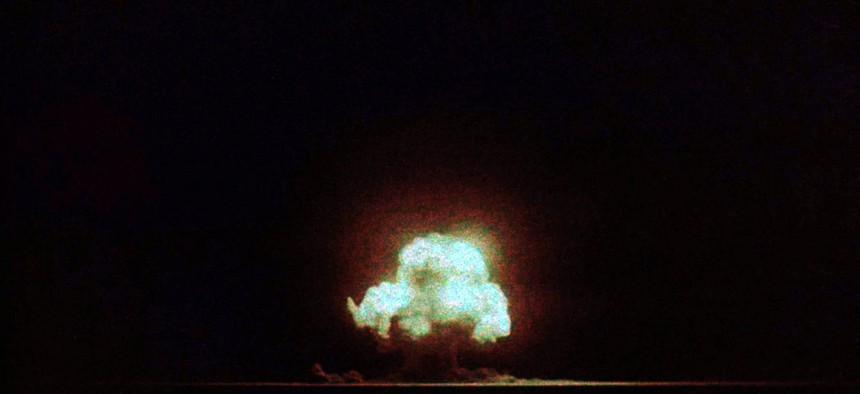America’s Network of Secret Bomb Detectors
Can a mysterious device help the government protect Northern Virginia from nukes?
Stop on the sidewalk on a downtown street in any large American city, and take a look around. Check out the utility poles nearby, the metal boxes planted at the street corners, the cameras dangling from awnings and eaves. Urban infrastructure is made up of thousands upon thousands of moving parts, and many of the gizmos that make a city run are designed to do their jobs without attracting too much attention.
Now, a mysterious new device may be coming to Arlington County, the wealthy part of Northern Virginia just outside of Washington, D.C. that’s home to the Pentagon, the Office of the Director of National Intelligence, and the CIA. According to the Defense Department, the new device is for bomb detection—but that’s about as much as they’d like anybody to know about it.
Earlier this year, a branch of the Defense Department called the Defense Threat Reduction Agency (DTRA) approached Arlington County with a request to install the bomb detector somewhere on county property. (The county owns a lot of land and all sorts of structures: schools, post offices, libraries, recycling centers, and so forth.) But the request came with a stipulation that the nature of the device and its location be kept secret. The county board will vote on the request later today.
In the event of a catastrophic explosion—a nuclear attack, for example—the bomb detector would use an array of sensors to try to determine where the blast took place, the type of bomb that went off, and the person or group behind the attack. It monitors seismic, sound, air pressure, radiation, light, and radio frequency signals, according to a DTRA spokesperson.
But the proposed Arlington device isn’t working alone: It would be just one in a system of equipment called Discreet Oculus, DTRA says. Outlined in depth inScience magazine earlier this year, Discreet Oculus takes the sensor technology that once populated nuclear test sites in Nevada and New Mexico and “repackages” it for use in urban environments. The agency claims the detectors could act as a deterrent: If an attacker knows their bomb will be traced and located, the thinking goes, they might think twice before striking.
The Defense Department won’t reveal how many Discreet Oculus devices are in the wild, or where they’re located. But a budget document released last year said the system would be tested first in three cities—Washington, New York, and Boston—before being rolled out to a total of 10 cities nationwide.
In a letter to Arlington County dated February 11, a colonel at DTRA wrote that exposing the proposed device’s location or the way it functions would “jeopardize the ability for the system to provide valuable information in a timely fashion,” because an adversary could use that information to defeat the system. The DTRA asked the county to keep the details about the equipment secret—and to exempt the information from Virginia’s freedom of information laws.
Given that the Oculus devices pick up such a wide range of signals, the stealth surrounding the program worries Jay Stanley, a senior policy analyst at the American Civil Liberties Union. “The level of secrecy here to measure physical phenomena seems excessive, and it raises concerns about whether this is the unnecessary knee-jerk secrecy that we often see from national-security agencies,” he said.
One of Stanley’s concerns had to do with the devices’ audio-recording capabilities. If the equipment could pick up conversations, they might violate state wiretap laws, he said. DTRA, meanwhile, says the sensors on its devices don’t record video or voice data.
(DTRA isn’t the only national-security agency with bomb-detection devices, by the way. In the lead-up to this year’s Super Bowl in the San Francisco Bay Area, a spate of strange devices started popping up on sidewalks. They turned out to be “aerosol collectors” deployed by the Department of Homeland Security, which sniff the air for biological agents from a chemical weapons such as a dirty bomb. A pair of Government Accountability Office reports—one published in 2008 andanother last year—determined that the devices aren’t very effective, and recommended holding off on expanding their use.)
Last week, Arlington’s county manager wrote to the county board with a recommendation to approve the Defense Department’s request for the new Discreet Oculus device—and for the attendant secrecy measures.
The public will have a chance to comment at the meeting before today’s vote. Stanley said a representative from the Virginia chapter of the ACLU will try to attend the meeting to emphasize some of the points the organization made in a letter it sent to the county board last week. In the letter, the Virginia chapter’s executive director called on the board to more thoroughly vet the Defense Department’s demands for secrecy and to push for more detailed specifications about the kinds of information the equipment would record and store.
But the measure will probably pass as is. “As it’s a matter of national security, I’d be surprised if they didn’t approve it,” said a spokesperson for the county. And if it does, the residents of Arlington County will soon have a new, attentive neighbor, which will join countless other secret data-gathering machines that dot the area’s streets and sidewalks.




